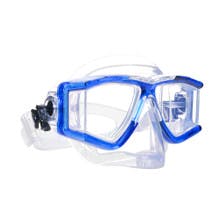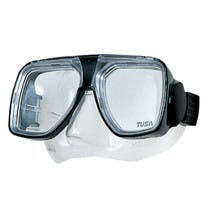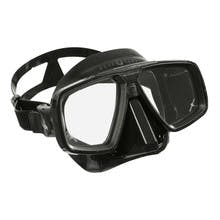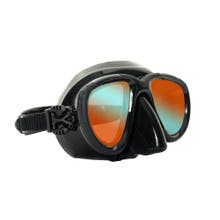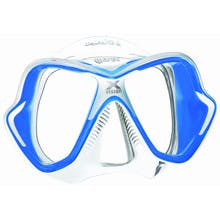Scuba Mask Buyer’s Guide

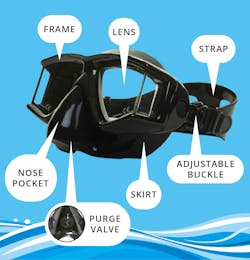
Before we get started with this Scuba Mask Buyer’s Guide, let’s ponder a certain question:
What’s the point of exploring the underwater world?
To see all the amazing marine animals and plant life, of course. And what’s the one piece of gear that will allow you to see it? Your mask. Technically, you could go out in the water with only your mask and have a fantastic time seeing all your fishy friends and fascinating coral. The other gear simply helps you stay underwater safely for extended periods of time. But the true magic of snorkeling and diving comes from the visual power of your mask. So, with that said, your mask is definitely one piece of equipment you’ll want to choose carefully so that you get the most vivid and ideal visual experience for you. How do you even get started on your hunt for the perfect mask? Don’t worry, that's why we created this Scuba Mask Buyer's Guide - to guide you through the process step by step. Now, let’s dive in.
How Can I Find the Best Fit for My Scuba Mask?
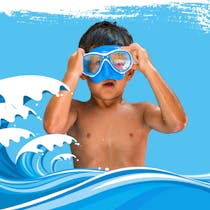
The Number One thing you’ll need from your dive mask no matter what activity you’re doing is a comfortable fit. If a mask doesn’t fit right, you risk water leaking in. You could also experience a more difficult time on your dive trying to make it fit. Neither of those outcomes are desirable. Although, both can be avoided if you purchase your mask on the basis of comfort and fit. When at your local Divers Direct, it’s easier to get the perfect fit because you can try the masks on. Here’s how:
Simply place the mask on your face (without using the strap) and lean your head back. Once there, lightly inhale so that the mask suctions to your face. Let go of the frame, then bring your head neutral again. When you exhale again, the mask should naturally fall off. If the mask falls off before you’ve exhaled, the mask is too big for your face.
Pro tip: Do not press the mask onto your face.
If you press the mask to your face, it will create a false seal and could cause you to pick the wrong size mask. The purpose behind this exercise is to be 100% sure the mask is the right fit. With the softness and flexibility of the skirts, it can seem like all scuba masks fit fine at first. But once you do this easy and handy fitting, you’ll know for sure if the fit is just right.
Scuba Mask Fitting When Buying Online:
If you’re buying online, that will disrupt your ability to try on the mask you’re considering. Don’t fret, sometimes the site will have the mask’s dimensions in the image or description so you can find the right measurements for your face. Usually, the description will at least let you know if it is suited for small, medium, or larger faces. If you have no idea what size your face is, just ask a friend to help you determine your face size. Once you get your new mask in the mail, try it on with the method explained above. If it turns out to be too big or small, check to see if you can return the mask for a different one. But, the best bet you have with getting your mask size just right on the first buy is by going into a dive shop to try them on.
What Mask Should I Get for My Favorite Activity?
The next stop in our Scuba Mask Buyer’s Guide is exploring what sort of activities you’ll be using your mask for. Will you be recreationally diving in bright, clear water? Are you planning to dive in dark or murky waters? Do you plan to go spearfishing? How about some underwater photography? Knowing your activity of choice will help you determine which of the following features you’ll want for your mask.
Scuba Mask Skirt Color:
One aspect to consider is skirt color. You’ll notice when shopping for masks that most masks have black skirts, others have clear skirts, and some even have colorful skirts like green, white, blue, etc. The point of a black skirted mask, like on the TUSA Paragon S Mask, is to help block out glare and overly bright light—kind of how a hat shades your eyes on a sunny day so you can see better. Underwater photographers tend to prefer black skirts and frames to better visualize the shot they’re hoping to capture. Most recreational divers who dive in clear waters like South Florida or the Bahamas also appreciate black/dark skirts to prevent glare and blinding brightness.
Otherwise, a clear or white skirt or frame could allow more light when in low light conditions. This is great for diving at night or in green or brown murky waters. Clear skirts, like on the ScubaPro Spectra Mask, also help people feel less claustrophobic in low light situations. Though, in high light/high visibility situations clear skirts can be a bit much. Colorful mask skirts don’t make too much of a difference in glare or brightness, though the same principle would theoretically follow that a lighter colored skirt (white) the more light may be allowed in and a darker skirt (green) would allow less light let in.
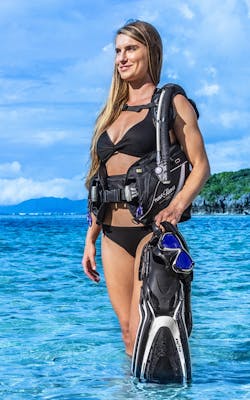
Scuba Mask Lens Color:
While on the subject of color, let’s discuss mirrored and colored lenses. Mirrored lenses act much like sunglasses do on the surface. They prevent glare and overly bright light from harming your eyes and impairing your vision. They’re especially beneficial for those with eyes sensitive to sunlight. But mirrored lenses aren’t just for protecting the eyes while diving or snorkeling, they are vital for anyone who jumps in the water to go spearfishing. Most folks who dive in with a speargun in hand prefer using mirrored lenses so that their prey can’t see their eyes. As fascinating as it is, when fish see your hungry eyes they tend to scurry off in a hurry, but with mirrored lenses, they’re actually drawn closer to you, making them much easier to catch.
Colored lenses are designed to enhance your vision underwater. Many are tinted in an amber color so that when you go deeper down, the colors that would potentially be lost are brought back to life through your lenses. In addition to enhancing the colors of your view, tinted and colored lenses often help relieve any straining of the eyes.
Scuba Mask Volume:
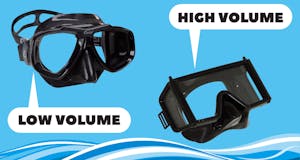
Now, what about mask volume? Your mask’s volume mainly makes a difference in how easy it is to clear your mask underwater and can affect your perspective. A low volume mask means that the frame and lenses sit closer to your face, reducing the amount of air within the mask. Lower volume masks also offer a wider range of view since the lenses are so close. Additionally, low volume masks mean less drag in the water, which make them especially popular for freediving.
Of course, if you’re a bit claustrophobic, a low volume mask may cause you to feel uncomfortable and a higher volume mask may be ideal for feeling like you have more space. Higher volume masks may take more effort to clear, but if you feel more comfortable in them, then they’re definitely worth it. Therefore, mask volume is essentially all about clearing ability and spatial awareness with a dash of field-of-view thrown in there.
What Field-of-View Should I Look for from My Scuba Mask?
Speaking of field of view, let’s dive into lenses and their shapes for a better understanding of their roles in how we see in the sea. Basically, there are many different lens designs and setups to choose from: two lenses, single lens, multi-lens, teardrop, panoramic, etc. These different styles are all designed specifically to alter the mask’s field of vision. Let’s rewind back to the beginning of this guide for a moment—what’s the point of underwater travel? To see. So, make sure your perspective through the mask is exactly as you like it.
To dig in a little deeper, single lens masks tend to have a better field of view than double lens masks (though they do tend to be higher in volume). Multi-lens masks usually mean there are additional lenses on the side that open up your peripheral vision for a more panoramic view. Teardrop style lenses are almost universally used in all masks as they open your vision for looking downward—this is especially helpful when you’re adjusting something on your BCD or looking for your gauges and other gear. So when it comes to the field of view, just know that there’s really no wrong choice here. The number and shape of your lenses are completely preferential to each diver, and again, by trying the mask on first, you’ll be able to get a feel for what type of view you like best.
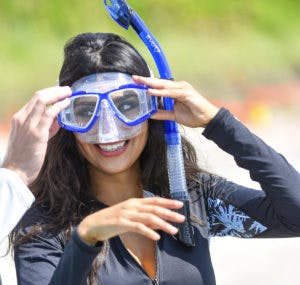
Corrective Underwater Vision:
You may also want to look into getting corrective lenses for your mask if you wear corrective eyewear on land. Replacing the lenses in your mask with corrective lenses is actually really neat since wearing contacts underwater isn’t the best idea, but you also can’t exactly wear your glasses underneath your scuba mask, now can you? No, you can’t. So, some brilliant diver decided to turn their scuba mask lenses into corrective lenses and they were generous enough to share this with the world. There are corrective lenses you can fully replace in your mask, and there are corrective lenses that you can simply fit in the inside of your mask.
How Do I Accessorize My Mask?
The final stop on our Scuba Mask Buyer’s Guide is a discussion about mask accessories. A question to ask yourself here may be—to purge or not to purge? Some scuba masks now come with a purge valve at the bottom of the nose pocket. This purge valve can make clearing your mask of water extremely easy. All you have to do is exhale through your nose and the water from the mask goes back into the sea. With a purge on your mask, you’ll have both your hands free for other things like taking photos and videos or holding onto your dive light.
Some divers prefer not to have a purge on their mask though, and for a few reasons. Perhaps the biggest deterrent to purges on masks is that it can make equalizing a tad more difficult. Additionally, if anything happens to go wrong with the purge, maybe it gets clogged with debris or it pops out or malfunctions, you’ll need to potentially carry a backup mask with you in the water, which means you’ll be clearing your mask the old fashioned way anyway. So you can weigh out the options for yourself to see what you may prefer.
Little Extras, Big Difference:
All the other aspects and varying features of your mask are fairly standard from mask to mask. The buckles for the straps are adjustable and nearly always mounted on the skirt. The skirts are usually made with silicone as is the nose pocket for equalization. The mask strap can tend to differ in material and design, but the strap can always be replaced for one better suited. There are a few accessories that you can add to your mask. These include camera mounts, snorkel keepers, and neoprene mask straps. Of course you’ll need to grab some defogger as well.
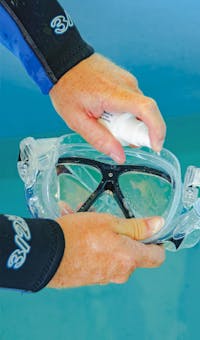
Defog Solution
Image from: Dive Training Magazine
So, make sure your visual experience underwater is exactly as you’d like it to be and appropriate for your potential activity. We hope this Scuba Mask Buyer's Guide has been helpful in leading you towards the perfect scuba mask for you.
Scuba Mask FAQs
How should a scuba mask fit?
A scuba mask should fit your face just right to create a watertight seal and be comfortable to wear. A scuba mask that’s too tight will be uncomfortable and frustrating. A mask that’s too loose won’t be able to hold the necessary watertight seal, causing overly frequent mask clearing. The best way to try on a scuba mask is to lean your head back, place the mask on (without the strap). Inhale lightly, then bring your head back to neutral. If it falls off, it’s too loose. If it feels like it’s squeezing your face, it may be too tight.
What does the purge valve on a dive mask do?
The purge valve on a dive mask is typically located right below your nose in the nose pocket. It features a one-way valve, and when you breathe out through your nose, any water that may have collected in your mask is pushed out quickly and easily.
Why does my scuba mask leak?
There are a couple reasons why your scuba mask may be leaking. The main one is that the mask may not fit correctly–it could simply be too large for your face. Or you could have a tear in your mask’s skirt or one of your lenses could be out of place. Be sure to check your mask for potential damage and, if repairable, get it fixed before your next dive. Finally, if you have long hair or a thick mustache, your hair could be getting into the skirt. This could prevent a proper watertight seal.
How do you stop a scuba mask from leaking?
If your scuba mask is damage-free and your hair isn’t a problem, your leakage issue is from an inappropriately-sized mask. Instead of trying to quick-fix the issue, it’s best to get yourself a new mask altogether. By stopping by your local Divers Direct and trying on some scuba masks using the fitting technique mentioned above, perhaps with a little guidance from one of our mask experts, you can find the perfect fitting mask for your face and fix your leakage issue once and for all.
How do you choose the right dive mask?
Choosing the right scuba mask will depend greatly on your niche diving activity, personal preferences, and face shape and size. It’s best to take a look at your personal interests as a diver (whether you’re into underwater photography or spearfishing) and your face size (do you have a large or small face?), then adjust your search accordingly so that you can find the proper fit for your face and activity. For more detail on how to choose the right mask for you, read through the Scuba Mask Buyer’s Guide above.
How do I get my scuba mask to stop fogging up?
When you buy a mask, you want to be sure you do the initial scrub to remove the lens film. Many masks manufacturers will come with a how-to to achieve this. Though, you can also use simple white toothpaste to get that foggy film off. There is also a mask accessory known as “spit” that you can use on your lenses before your dives. This spit keeps your mask from fogging up so you can better enjoy your dive.
What can I do to make my scuba mask fit properly?
If your mask doesn’t fit, you may be tempted to try some quick-fixes. Over-tightening your mask strap or squeezing your mask to your face won’t fix the problem long term. You will still be uncomfortable in your mask when doing this and could run the risk of water leaks and “squeeze” bruising around your face. The best thing to do is get yourself a new mask and make sure it's a proper fit for you.
Should I just wear contacts under my scuba mask?
No, you really don’t want to wear contacts underwater. When you clear your mask or if you need to take your mask off underwater, your contact could fall out. You definitely don’t want to touch your eye in saltwater. Many masks come with the option for corrective lenses you can use so that your vision through your mask can resemble your vision through your glasses.


